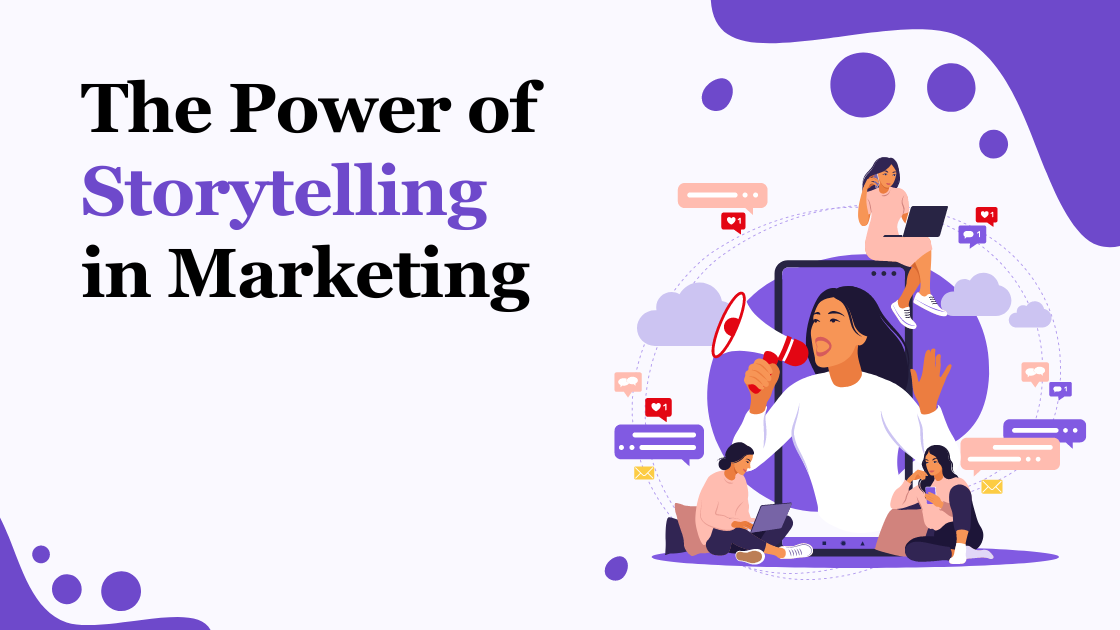In today’s saturated market, where consumers are constantly bombarded with advertisements and promotional messages, capturing attention has become more challenging than ever. What sets successful brands apart is their ability to connect with audiences on a deeper, emotional level—and storytelling is the tool that makes this possible. Far from being just a buzzword, storytelling in modern marketing is a powerful strategy that engages, inspires, and ultimately drives business success.
In this article, we’ll explore why storytelling matters in modern marketing, the elements of an effective story, and how you can incorporate it into your marketing strategy.

Why Storytelling Matters in Modern Marketing
Storytelling has been a cornerstone of human communication for centuries. It resonates with us because it appeals to our emotions, making ideas memorable and relatable. In marketing, a compelling story does more than sell a product—it creates a connection between the brand and its audience.
1. Emotional Engagement
Stories evoke emotions, and emotions drive decisions. When brands use storytelling, they go beyond transactional relationships to form emotional connections with their customers.
Example: Nike’s “Just Do It” campaigns often feature athletes overcoming challenges, inspiring audiences to believe in themselves and associate the brand with empowerment.
2. Building Trust and Authenticity
Consumers are more likely to trust brands that share authentic, relatable stories. Transparency and vulnerability in storytelling humanize brands, making them more approachable and credible.
Example: Dove’s “Real Beauty” campaign shares stories that challenge societal beauty standards, building trust and fostering loyalty.
3. Memorability
A well-told story sticks with the audience far longer than a list of product features. Stories make your message more engaging and memorable.
Research Insight: Studies show that people are 22 times more likely to remember a fact if it’s part of a story.
4. Differentiation
In a crowded marketplace, storytelling helps brands stand out by emphasizing their unique values and mission rather than just their products.
Example: Apple’s marketing emphasizes creativity and innovation through stories about users who create extraordinary work using Apple products.
Key Elements of Effective Storytelling in Marketing
To craft a compelling narrative, your story must resonate with your audience. Here are the key elements of effective storytelling:
1. A Relatable Hero
The hero of your story could be your customer, your brand, or even a symbolic character. The hero should face challenges that the audience can relate to and overcome them with the help of your product or service.
Example: Airbnb tells stories of travelers who have unique and heartwarming experiences, positioning itself as a bridge to adventure and belonging.
2. A Clear Problem
Every great story revolves around a conflict or challenge. In marketing, the problem should reflect a pain point your audience experiences. The resolution? Your product or service.
Example: Slack’s marketing often focuses on the chaos of unorganized team communication, showing how its platform simplifies collaboration.
3. Emotionally Charged Narrative
Emotion is the glue that makes stories stick. Whether your story inspires, motivates, or even tugs at heartstrings, it should evoke feelings that align with your brand’s values.
Example: Coca-Cola’s holiday campaigns evoke nostalgia and warmth, tying their brand to joyous, family-filled moments.
4. A Satisfying Resolution
The resolution is where your product or service plays the role of the hero’s guide, helping them overcome their challenges and achieve their goals.
Example: Grammarly’s ads show individuals struggling with writing and then succeeding after using the tool, positioning Grammarly as the key to effective communication.
5. Call to Action
A good story not only entertains but also inspires action. Include a clear and compelling call to action that ties the story back to your brand’s goals.
Example: A campaign might end with, “Join our community today and write your own success story.”
How to Incorporate Storytelling into Your Marketing Strategy
Storytelling can be woven into every aspect of your marketing, from content creation to customer interactions. Here’s how to get started:
1. Know Your Audience
Understanding your audience’s desires, challenges, and values is essential to creating stories that resonate.
Steps:
- Conduct surveys or interviews to gather insights into your audience’s pain points.
- Use analytics tools to understand their preferences and behavior.
Example: Patagonia’s marketing focuses on environmentally conscious consumers, telling stories about sustainability and eco-friendly practices.
2. Choose the Right Medium
Different stories work best on different platforms. Select the medium that aligns with your story and audience.
Examples:
- Social Media: Short, impactful stories work well on Instagram or TikTok.
- Video Campaigns: Longer, more immersive stories can be shared on YouTube or as commercials.
- Blogs and Case Studies: In-depth stories about customer success or product innovation resonate well on blogs and LinkedIn.
3. Leverage User-Generated Content
Encourage your customers to share their own stories about how your brand has impacted their lives. This builds authenticity and trust.
Example: GoPro features videos captured by its users, showcasing the adventures their cameras make possible.
4. Use Data to Personalize Stories
Tailor your stories based on audience segments to ensure relevance and engagement.
Example: Spotify Wrapped uses user data to create personalized year-end stories about their listening habits, making customers feel valued and understood.
5. Create a Consistent Brand Narrative
Your storytelling should align with your brand’s mission, values, and voice. Consistency builds trust and helps audiences identify with your brand.
Example: Tesla’s narrative consistently revolves around innovation and sustainability, reinforcing its identity as a forward-thinking brand.
Examples of Successful Storytelling Campaigns
1. Always: #LikeAGirl
Always’ campaign challenged negative stereotypes about what it means to do something “like a girl.” By sharing empowering stories, the brand connected with a global audience and redefined a cultural narrative.
2. Nike: “You Can’t Stop Us”
Nike’s campaign showcased athletes overcoming challenges during the pandemic, using a split-screen visual technique to tell an inspiring and emotionally charged story.
3. John Lewis: Holiday Ads
John Lewis, a UK retailer, creates heartwarming holiday ads that tell emotional stories about connection and generosity, building anticipation and engagement every year.
Common Mistakes to Avoid
1. Overloading with Facts
While data is important, stories should focus on emotions rather than overwhelming the audience with statistics.
2. Forgetting the Audience
Stories that don’t address the audience’s needs or interests risk falling flat.
3. Lack of Authenticity
Inauthentic or exaggerated stories can harm your brand’s reputation.
Conclusion: The Power of Stories in Marketing
Storytelling is more than a marketing tactic—it’s a way to build meaningful connections with your audience. By tapping into the universal appeal of stories, brands can inspire action, foster loyalty, and differentiate themselves in a crowded marketplace.
As you craft your marketing strategy, remember that the most compelling stories are authentic, emotionally resonant, and audience-focused. Embrace storytelling, and watch as your brand transforms into more than just a business—it becomes a source of inspiration and connection.
Discover more from Personal Blog of Richard Tong
Subscribe to get the latest posts sent to your email.





Looking forward to reading more. Great blog post.Really looking forward to read more. Really Cool.
Hmm is anyone else encountering problems with the images on this blogloading? I’m trying to determine if its a problem on my end or if it’sthe blog. Any feed-back would be greatly appreciated.
I was recommended this blog by my cousin. I am not sure whether this post is written by him as nobody else know such detailed about my difficulty.You’re incredible! Thanks!
Tiktok takipçi satın almak için, yıllardır en kurumsal hizmet veren takipcisepette ile güvenilir takipçi satın al.
To buy TikTok followers, buy reliable followers with takipcisepette, which has been providing the most corporate service for years.
Inspiring quest there. What occurred after?Thanks!Feel free to visit my blog :: Body Core Keto
Awesome post.Thanks Again. Really Cool.
I loved your post.Really thank you! Keep writing.
I appreciate you sharing this blog.Thanks Again. Great.
Im obliged for the blog article. Awesome.
Hey, thanks for the article.Really thank you! Really Great.
This is one awesome blog post.Much thanks again. Cool.
I value the article post.Thanks Again.
Major thanks for the blog article. Want more.